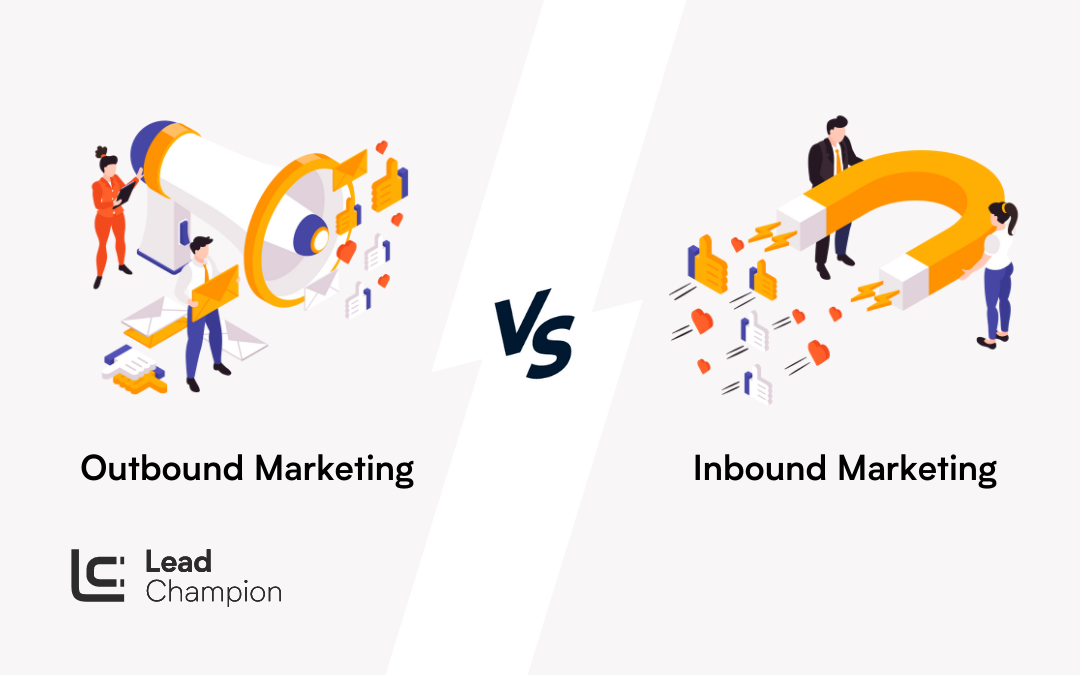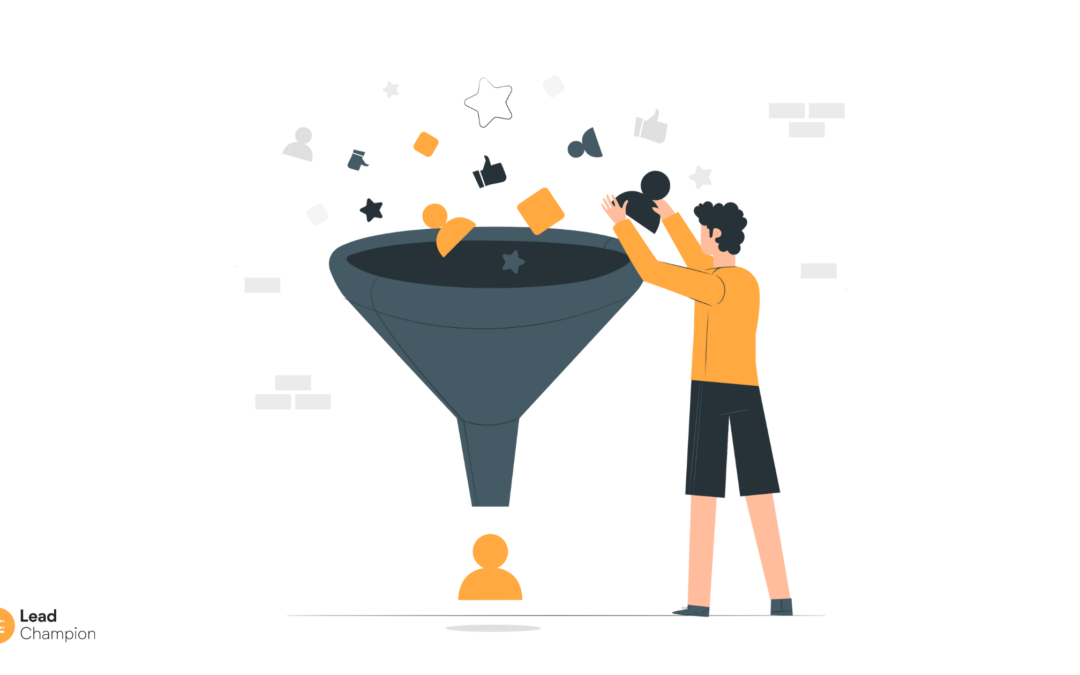Have you spent a lot of resources promoting your product or service online but not acquiring new customers? You’re in the right place!
There has been increasing talk lately about an incredibly effective strategy for acquiring customers: lead generation.
You’re probably not clear on what B2B lead generation is and how to build a lead generation strategy, but you’d like to explore it further.
In fact, lead generation has become a key strategy in B2B marketing.
Given the importance of the topic, we created this guide to help you understand how to put in place a lead generation strategy that can guarantee you will acquire an incredible number of customers.
Small spoiler: in this article we will tell you about a marketing tool that can revolutionize B2B lead generation: how? By showing you companies that visit your website. Learn more about the B2B marketing tool Lead Champion discover.
Let’s begin with our guide and start with the basics: what is lead generation? And most importantly, how does it work?
B2B lead generation goals for 2023
Acquiring new customers is obviously the goal of any business. Let’s first see what we mean when we talk about “acquiring customers.”
Nowadays, given the competitiveness of online marketing, it is essential to keep in mind the basic steps of this process.

The buyer journey in B2B lead generation
Acquiring customers means acting on three main steps in the so-called lead generation funnel (which we will elaborate on shortly):
- Awareness: making potential customers aware of a need, product or service
- Consideration: getting the potential customer to consider buying a solution
- Decision: acquiring new customers by leading them to decide specifically for our product or service.
This is a natural path, which needs its own timing but above all a key concept: mutual trust.
In this article we will see in detail just how to articulate B2B lead generation strategies in order to succeed in all three macro-steps and create a profitable relationship that really generates new customers.
What is Lead Generation?
Lead generation is the process of maximizing the number of potential customers through strategic use of digital channels. It is based on the three buyer’s journey steps: awareness, consideration and decision.
Lead generation is not what many people think it is, which is buying lists of contacts. Doing B2B lead generation in a truly effective way to create a genuine relationship with the customer, to the point where that customer itself becomes the primary lead generation vehicle through the oldest and still most effective marketing tactic: word of mouth.
From traditional marketing to B2B lead generation
In the common understanding, through marketing operations, the company must somehow move toward the customer, attracting their attention with various forms of advertising.
After the technological revolution and the so-called “Information Society,” the context has radically changed as the information and sensory overload to which users are subjected has led to a drastic decrease in their sensitivity.
The attention span is significantly lower than in the past.
This is referred to as the “Attention Economy.” A real market in which companies compete to grab a few seconds (in lucky cases even a few minutes!) of attention from potential customers.
There has been a shift from a model in which the company was focused on itself, its products and features, to a new context in which the primary focus becomes the (potential) customer’s need and want.
Some call this “customer centricity“, but in reality it is nothing more than the first requirement to do what we call lead generation.
At the same time, the directionality of the relationship has also changed. It is no longer the company that moves toward the customer, rather it is the customer that moves toward the company. This occurs at the moment when they need answers, solutions or needs to meet specific requirements.
The process of approaching the purchase then becomes more natural, spontaneous and conscious. This is referred to as a shift from purely outbound marketing to inbound marketing strategies.

The corporate mission must then focus more on providing concrete answers to the needs and wants of potential customers.
By doing so, information-seeking users will learn about your brand through contents you offer. In addition, the fact that you have fulfilled a need or solved a problem through your expertise will help create a stronger and more lasting bond, which will greatly facilitate progress on the path to purchase.
Lead generation: what does it mean?
Before explaining further, we should answer an obvious question: what does “lead” mean?
What is a lead (meaning)
A “Lead” is an entity, person or company, that has shown concrete interest in a product or service.
Lead generation is therefore the process by which a company works to find leads, that is, to increase the number of contacts from potential customers, or B2B leads.
An effective B2B lead generation strategy must therefore start with an attempt to engage as broad a base of users as possible and subsequently turn them into leads, with the ultimate goal of lead generation being to bring in more sales.
Doing lead generation therefore means creating interest in your business from new potential customers.
Lead generation is a multifaceted process, requiring action in several directions, and the effectiveness of each stage is verified through precise metrics.
Let’s now look in detail at each stage of this action plan and the appropriate strategies for each phase.
The B2B lead generation funnel: how to acquire customers
The visual metaphor of the funnel represents how many people/businesses will come in contact with your business, but only a few will eventually become customers.
Clearly, the purpose of effective B2B lead generation is to make the funnel have as little difference as possible between its initial and final stages.

In marketing, we then talk about the three macro-phases as seen above: awareness, consideration and decision.
These three phases are also called Top of the Funnel, Middle of the Funnel and Bottom of the Funnel (i.e., initial, middle and final phases).
The funnel can be defined as the visual representation of these concepts.

However, talking about “high” or “low” can be risky. This somehow assumes that there is an order of importance among the stages.
Actually, the typical mistake companies make is to focus exclusively on the final stage (the direct acquisition of new customers) while neglecting the natural conversion path, which cannot be separated from awareness and the intermediate stage in which the relationship matures.
B2B lead generation: a transformational process
As you could see, lead generation is a fairly complex process, consisting of a sequence of well-structured steps and objectives.
The funnel is – in itself – simply a model that helps simplify a process; it can be read and used in different ways to create a B2B lead generation strategy. Very different activities can also be deployed: think also of using telemarketing to create lead generation campaigns.
The basic concept must be only one: the potential customer does not want to waste time or feel cornered, they need to calmly evaluate solutions and decide for the brand that has demonstrated more competence, authority and ability to communicate how it will be able to solve their problems or improve their life.
Doing this requires great dedication and study of the so-called buyer personas and keeping a fundamental concept in mind: we need to imagine for our customer a process of almost transforming their identity.
What is the change that our solution can bring to their daily life? Who does our customer want to become?
Michael Schrage, an MIT innovation expert, says that without asking this question it becomes impossible to produce an effective lead generation marketing strategy.
If we have interfaced with the right stakeholders (buyer personas) and succeeded in conveying our idea of transformation then we will have no problem getting results for our lead generation.
Advancement in the funnel is nothing more than the buyer’s journey. A journey in which we help our lead (or potential customer) approach our products and services through our messages.
Only the results given by an analysis of B2B lead generation metrics will be able to give you a concrete understanding of the effectiveness of your lead generation (one metric out of all is lead scoring).
Finally, we leave you with an idea that can be revolutionary for your B2B business.
Lead Champion discover: the marketing tool that revolutionizes B2B lead generation
Would you like to get qualified leads even from users who haven’t filled out forms? Now you can!
Lead Champion discover revolutionizes traditional B2B marketing and lead generation strategies: it allows you to acquire leads even without a form being filled out.
The Lead Champion discover B2B marketing tool analyzes your website traffic by identifying, via IP tracking, which companies visited your site, making it the ideal choice for B2B companies that want to implement Account Based Marketing strategies.
Discover is distributed as Software-As-A-Service, so it can be easily accessed through a convenient web interface that shows your leads in real-time. Take advantage of the free demo now to discover our service!
FAQ
Let’s answer the most common questions about Lead Generation!
What is lead generation?
It is the process of creating the largest possible number of potential customers
What is a lead?
A “lead” is defined as a potential customer whose contact information we possess
How to start with lead generation
The first step is definitely to define Buyer Personas, which are sort of IDs representing potential customers
How to do lead generation
Lead generation requires the application of the so-called “funnel”
What is the lead generation funnel?
The funnel diagram is used to represent the different stages of the buying journey. The stages are awareness, consideration and decision. Obviously in the top stages there will be a high number of potential customers while in the bottom stage only those who have converted into new customers.
How does lead generation work?
Applying lead generation means operationalizing 4 phases. The first is planning and defining Buyer Personas, followed by the Top of the funnel (approaching the awareness phase), the Middle of the funnel (approaching the consideration phase) and the Bottom of the funnel (approaching the decision phase).
Facebook lead generation: come si fa?
LinkedIn lead generation: how to start
Linkedin is the main channel when it comes to B2B. It is a great channel, but it needs to be contextualized within the funnel. You have to ask yourself if you can intercept your audience with content that is useful for all three stages of the funnel. For example: are you doing awareness to connect with the widest possible pool of users? Are you prompting people to consider your product or service by cultivating the relationship? Do you have more sales-oriented content such as case studies?

